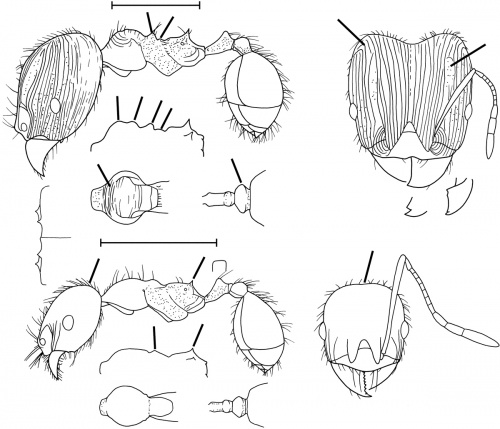Pheidole indica
| Pheidole indica | |
|---|---|

| |
| Scientific classification | |
| Kingdom: | Animalia |
| Phylum: | Arthropoda |
| Class: | Insecta |
| Order: | Hymenoptera |
| Family: | Formicidae |
| Subfamily: | Myrmicinae |
| Tribe: | Attini |
| Genus: | Pheidole |
| Species group: | fervens |
| Species: | P. indica |
| Binomial name | |
| Pheidole indica Mayr, 1879 | |
| Synonyms | |
| |
| Common Name | |
|---|---|
| Indo-oozu-ari | |
| Language: | Japanese |
Fischer and Fisher (2013) - Pheidole teneriffana (=P. indica) is an invasive species with collection records scattered over several continents and islands across the globe. Described from the Canary Islands and found widely distributed throughout the greater Mediterranean region, its native range and origin are unknown (Wilson 2003, Wetterer 2011). Probably introduced to the Malagasy region, it was described from Madagascar as P. voeltzkowii, only one year after the publication of the senior synonym. Morphologically, P. teneriffana can be grouped together with, and is possibly related to, Pheidole fervens, Pheidole oceanica and Pheidole sinaitica. In the New World, Pheidole teneriffana has been introduced to California (Martinez 1992, Snelling 1992), Cuba, Peru (Wilson 2003), and the West Indian islands (Wetterer 2011). It seems to be common in dry habitats (Wetterer 2011), especially along coasts and in urban areas (Collingwood et al. 1997, Gómez & Espalader 2006), and has been described as aggressive toward other ant species, locally abundant, and spreading in urban areas (Collingwood 1985, Gómez & Espalader 2006). In the Malagasy region P. teneriffana was collected on the Comoros, Mauritius, the Seychelles, and from coastal towns in Madagascar, usually from under stones, ground nests, or foraging on the ground or lower vegetation in urban or garden habitats at elevations between 2 and 296 m, on Mayotte in native littoral and secondary forest (7 m elevation). Recently in Saudi Arabia it was collected from soil, under stones, and foraging on the ground on a few farms at elevations between 570 and 1620 m.
In Japan, this species is found in rather dry habitats and is common in southern Kyushu. Nest entrances sometimes involve small mounds of sand or soil particles. Total worker/soldier numbers in colonies can run to almost 1,000 individuals (Yano, pers. comm.; Iida, pers. comm.). Worker recruitment patterns were reported by Magata & Yamane (1989), and division of labor in the worker caste by Yano & Yamane (1990). (Japanese Ant Image Database)
| At a Glance | • Highly invasive |
Identification
A member of the Pheidole fervens species group. Fischer and Fisher (2013) - Moderately small species (WL major 1.18–1.44 mm, WL minor 0.79–0.97 mm), minor workers with relatively long scapes and legs (SI minor 120–149, FI minor 134–170) and major workers with moderately long legs (FI major 73–89), both with a well-developed promesonotal process. Major with frontal carinae and antennal scrobe reaching posterior quarter of head, face with longitudinal rugae often very oblique posteriorly, curved toward posterolateral lobes, eyes moderately large (EI 13–16), submedian hypostomal teeth small, median process reduced and often very shallow, promesonotal process prominent and well developed, in profile metanotal groove shallow and dorsal propodeum usually level, postpetiole in dorsal view trapezoidal, often with rounded lateral corners, but sometimes with acute lateral dents, postpetiole between 1.9 and 2.5 times wider than petiole, postpetiolar ventral process reduced and very shallow. Minor head oval, posteriorly rounded, scapes and legs relatively long (SI 120–149, FI 134–170), with decumbent to subdecumbent pilosity, eyes relatively large (EI 25– 30), metanotal groove not or barely impressed in profile.
Japan
Similar to Pheidole megacephala, Pheidole fervens and Pheidole nodus. Pheidole indica can be distinguished from P. megacephala by the extent of posterior cephalic sculpturation in soldiers and the separately raised mesonotum in soldiers and workers; from P. fervens, by the dark-colored body, larger eyes and upwardly directed propodeal spines in soldiers and workers; and from P. nodus by the smaller postpetiole. (Japanese Ant Image Database)
Keys including this Species
- Key to the Pheidole of North Vietnam
- Key to Pheidole of the islands of the Southwest Indian Ocean
- Key to New World Pheidole Species Groups
- Key to workers of the Socotra Archipelago, Yemen
- Key to Pheidole of Hispaniola
Distribution
An invasive species that has been reported occurring in the Canary Islands, the Mediterranean area, the Malagasy region, California, Cuba, Peru, and West Indian islands.
Distribution
Latitudinal Distribution Pattern
Latitudinal Range: 32.812778° to 20.92583°.
| North Temperate |
North Subtropical |
Tropical | South Subtropical |
South Temperate |
- Source: AntMaps
Distribution based on Regional Taxon Lists
Afrotropical Region: Comoros, Eritrea, Kenya, Saint Helena, Saudi Arabia, Socotra Archipelago, United Arab Emirates, Yemen.
Malagasy Region: Madagascar, Mauritius, Mayotte, Seychelles.
Nearctic Region: United States.
Neotropical Region: Antigua and Barbuda, Barbados, Colombia, Cuba, Dominican Republic, Greater Antilles, Guadeloupe, Peru.
Oriental Region: Bangladesh, India (type locality), Nepal, Pakistan, Sri Lanka.
Palaearctic Region: Balearic Islands, Canary Islands (type locality), China, Cyprus, Egypt, Greece, Iberian Peninsula, Iran, Israel, Japan, Kuwait, Malta, Oman, Republic of Korea, Spain, Türkiye.
Distribution based on AntMaps
Distribution based on AntWeb specimens
Check data from AntWeb
Countries Occupied
| Number of countries occupied by this species based on AntWiki Regional Taxon Lists. In general, fewer countries occupied indicates a narrower range, while more countries indicates a more widespread species. |
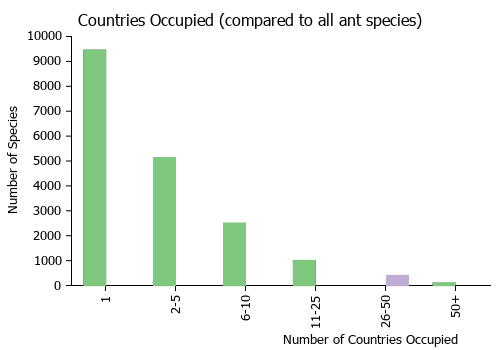
|
Estimated Abundance
| Relative abundance based on number of AntMaps records per species (this species within the purple bar). Fewer records (to the left) indicates a less abundant/encountered species while more records (to the right) indicates more abundant/encountered species. |

|
Biology
Wilson (2003) - Evidently a native of North Africa and possibly also the Canary Islands. It has turned up in disturbed habitats in Cuba, Peru, and California, but as of this writing is evidently still sporadic and local. In 1989 Martinez (1992) found a population occupying about two hectares of Admiral Kidd Park, evidently consisting of a single continuous, polydomous colony. The separate nests contained large numbers of workers and multiple inseminated queens, as many as 23 in one instance. Nest sites included lawns and open ground, where nest entrances were surmounted by mounds of excavated soil; crevices of sidewalks and curbs; and the bases of trees. New nest sites were occupied by budding from occupied sites. The workers were aggressive toward other ant species; they preyed on insects and harvested seeds. By 1998, according to Gulmahamad and Martinez (1999), the population was extinct. It had been weakened by attempts to exterminate it and changes in the nest habitat, and given the coup de grâce by encroaching Argentine ants (Linepithema humile).
Regional Notes
Heterick (2009) - WA Australia: Currently only confirmed for the Fremantle area, but ants of similar appearance have been seen in Claremont (a Perth suburb) and the wheatbelt town of York. Unlike the case with most nests of Pheidole megacephala, this species has diurnally active workers. Pheidole indica had not previously been reported from Australia.
Espadaler (2007) - Canary Islands: A nest with winged males was detected on cracks in the pavement. Ants rushed out after a small air blow with the aspirator.
Association with Other Organisms
 Explore: Show all Associate data or Search these data. See also a list of all data tables or learn how data is managed.
Explore: Show all Associate data or Search these data. See also a list of all data tables or learn how data is managed.
Hemiptera
- This species is a mutualist for the aphid Aphis craccivora (a trophobiont) (Shiran et al., 2013; Saddiqui et al., 2019) (as Pheidole teneriffana).
- This species is a mutualist for the aphid Aphis umbrella (a trophobiont) (Shiran et al., 2013; Saddiqui et al., 2019) (as Pheidole teneriffana).
Fungi
This species is a host for the fungus Myrmicinosporidium durum (a pathogen) in Japan (Hosoishi et al., 2020).
Castes
Minor
Images from AntWeb
   
| |
| Worker. Specimen code casent0005778. Photographer April Nobile, uploaded by California Academy of Sciences. | Owned by UCDC, Davis, CA, USA. |
Images from AntWeb
   
| |
| Syntype of Pheidole voeltzkowii. Worker. Specimen code casent0101327. Photographer Nick Olgeirson, uploaded by California Academy of Sciences. | Owned by MHNG, Geneva, Switzerland. |
   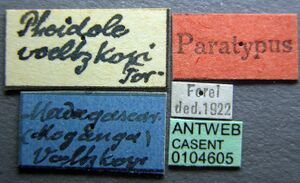
| |
| Type of Pheidole voeltzkowii. Worker. Specimen code casent0104605. Photographer April Nobile, uploaded by California Academy of Sciences. | Owned by ZMHB, Berlin, Germany. |
   
| |
| Worker. Specimen code casent0173013. Photographer April Nobile, uploaded by California Academy of Sciences. | Owned by MCZ, Cambridge, MA, USA. |
   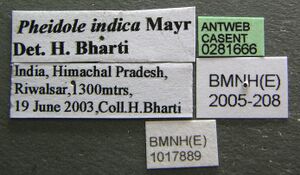
| |
| Worker. Specimen code casent0281666. Photographer Estella Ortega, uploaded by California Academy of Sciences. | Owned by NHMUK, London, UK. |
  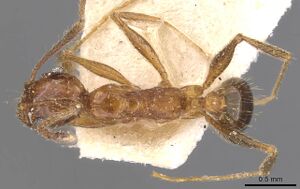 
| |
| Paralectotype of Pheidole indica himalayana. Worker. Specimen code casent0907898. Photographer Will Ericson, uploaded by California Academy of Sciences. | Owned by MHNG, Geneva, Switzerland. |
   
| |
| Paralectotype of Pheidole indica rotschana. Worker. Specimen code casent0907900. Photographer Will Ericson, uploaded by California Academy of Sciences. | Owned by MHNG, Geneva, Switzerland. |
   
| |
| Type of unavailable quadrinomial: Pheidole javana jubilans formosae. Worker. Specimen code casent0907916. Photographer Will Ericson, uploaded by California Academy of Sciences. | Owned by MHNG, Geneva, Switzerland. |
    
| |
| Worker. Specimen code casent0101745. Photographer Michele Esposito, uploaded by California Academy of Sciences. | Owned by MHNG, Geneva, Switzerland. |
Major
Images from AntWeb
   
| |
| Syntype of Pheidole voeltzkowii. Worker (major/soldier). Specimen code casent0101326. Photographer Nick Olgeirson, uploaded by California Academy of Sciences. | Owned by MHNG, Geneva, Switzerland. |
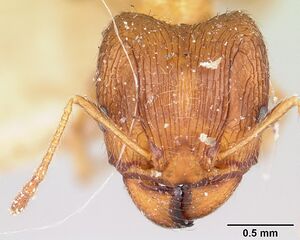 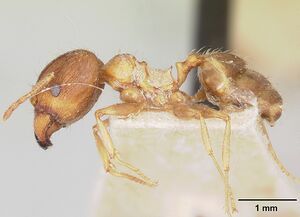  
| |
| Syntype of Pheidole voeltzkowii. Worker (major/soldier). Specimen code casent0101564. Photographer April Nobile, uploaded by California Academy of Sciences. | Owned by MHNG, Geneva, Switzerland. |
   
| |
| Type of Pheidole voeltzkowii. Worker (major/soldier). Specimen code casent0104604. Photographer April Nobile, uploaded by California Academy of Sciences. | Owned by ZMHB, Berlin, Germany. |
   
| |
| Worker (major/soldier). Specimen code casent0173012. Photographer April Nobile, uploaded by California Academy of Sciences. | Owned by MCZ, Cambridge, MA, USA. |
   
| |
| Paralectotype of Pheidole indica. Worker. Specimen code casent0906612. Photographer Estella Ortega, uploaded by California Academy of Sciences. | Owned by NHMW, Vienna, Austria. |
 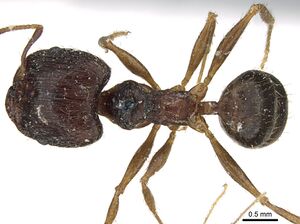  
| |
| Paralectotype of Pheidole indica. Worker (major/soldier). Specimen code casent0906613. Photographer Estella Ortega, uploaded by California Academy of Sciences. | Owned by NHMW, Vienna, Austria. |
   
| |
| Lectotype of Pheidole indica himalayana. Worker (major/soldier). Specimen code casent0907897. Photographer Will Ericson, uploaded by California Academy of Sciences. | Owned by MHNG, Geneva, Switzerland. |
   
| |
| Lectotype of Pheidole indica rotschana. Worker (major/soldier). Specimen code casent0907899. Photographer Will Ericson, uploaded by California Academy of Sciences. | Owned by MHNG, Geneva, Switzerland. |
   
| |
| Type of unavailable quadrinomial: Pheidole javana jubilans formosae. Worker (major/soldier). Specimen code casent0907915. Photographer Will Ericson, uploaded by California Academy of Sciences. | Owned by MHNG, Geneva, Switzerland. |
   
| |
| Worker (major/soldier). Specimen code casent0005777. Photographer April Nobile, uploaded by California Academy of Sciences. | Owned by UCDC, Davis, CA, USA. |
Male
Images from AntWeb
 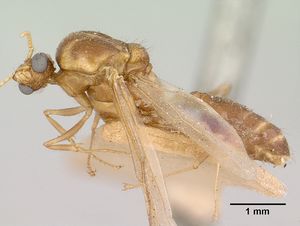  
| |
| Syntype of Pheidole voeltzkowii. Male (alate). Specimen code casent0101325. Photographer Nick Olgeirson, uploaded by California Academy of Sciences. | Owned by MHNG, Geneva, Switzerland. |
Nomenclature
The following information is derived from Barry Bolton's Online Catalogue of the Ants of the World.
- indica. Pheidole indica Mayr, 1879: 679 (s.w.q.) INDIA. Forel, 1902c: 199 (m.); Imai, Baroni Urbani, et al. 1984: 6 (k.). Senior synonym of himalayana, rotschana, striativentris and material of the unavailable name formosae referred here: Eguchi, 2004: 198. See also: Bingham, 1903: 263; Menozzi, 1939a: 298; Ogata, 1982: 196.
- striativentris. Pheidole striativentris Mayr, 1879: 678 (s.) INDIA. Forel, 1902c: 195 (w.q.). Junior synonym of indica: Eguchi, 2004: 199.
- himalayana. Pheidole indica r. himalayana Forel, 1902c: 185 (s.), 199 (w.) INDIA. [Also described as new by Forel, 1902f: 546.] Raised to species: Bingham, 1903: 265. Subspecies of indica: Emery, 1921f: 91; Menozzi, 1939a: 298; Pisarski, 1967: 385. Junior synonym of indica: Eguchi, 2004: 198.
- rotschana. Pheidole indica r. rotschana Forel, 1902c: 185 (s.), 199 (w.m.) INDIA. Imai, Baroni Urbani, et al. 1984: 6 (k.). [Also described as new by Forel, 1902f: 546.] Raised to species: Bingham, 1903: 264. Subspecies of indica: Forel, 1909e: 394; Forel, 1911i: 222. Junior synonym of indica: Eguchi, 2004: 199.
- teneriffana. Pheidole teneriffana Forel, 1893d: 465 (s.w.) SPAIN (Canary Is). [Also described as new by Forel, 1894a: 160.] Santschi, 1908: 521 (q.). Gómez & Espadaler, 2006: 229 (m.). Status as species: Santschi, 1908: 521; Wheeler, W.M. 1922a: 821; Wheeler, W.M. 1927g: 105; Aguayo, 1932: 219; Finzi, 1936: 164; Baroni Urbani, 1968b: 438; Baroni Urbani, 1971c: 73; Barquin Diez, 1981: 114; Schembri & Collingwood, 1981: 428; Collingwood, 1985: 255; Agosti & Collingwood, 1987b: 271 (in key); Snelling, R.R. 1992b: 121; Mei, 1995: 762; Collingwood & Agosti, 1996: 324; Wilson, 2003: 640 (redescription); Collingwood, et al. 2004: 478; Gómez & Espadaler, 2006: 229; Heterick, 2009: 169; Fischer & Fisher, 2013: 346 (redescription). Senior synonym of taina: Wilson, 2003: 640. Senior synonym of voeltzkowii: Fischer & Fisher, 2013: 346. Junior synonym of indica: Sarnat, et al. 2015: 46.
- taina. Pheidole teneriffana subsp. taina Aguayo, 1932: 219 (s.) CUBA. Junior synonym of teneriffana: Wilson, 2003: 640.
- voeltzkowii. Pheidole voeltzkowii Forel, 1894e: 227 (s.w.m.) MADAGASCAR. Forel, 1897c: 207 (q.). Junior synonym of teneriffana: Fischer & Fisher, 2013: 340.
Type Material
Tenerife, Canary Islands. Musee d'Histoire Naturelle Genève - as reported in Wilson (2003)
Description
Wilson (2003) - DIAGNOSIS Major: unique in the possession of a broad, convex metanotum and a four-lobed mesosomal profile in dorsal-oblique view (2 on pronotum, one each on mesonotum and metanotum); also, presence of a weak antennal scrobe; carinulae cover all the dorsal head surface except for the frontal triangle and midclypeus; carinulae originating laterad to antennal scrobes circle outward and downward again to travel to the eye and behind it; postpetiole elliptical from above.
Minor: occiput slightly narrowed, no nuchal collar.
MEASUREMENTS (mm) Major (Oriente, Cuba): HW 1.34, HL 1.34, SL 0.82, EL 0.20, PW 0.64. Minor (Oriente, Cuba): HW 0.62, HL 0.70, SL 0.74, EL 0.14, PW 0.34.
COLOR Major and minor: light yellowish brown, with head, mandibles, and gaster a slightly darker shade.
Fischer and Fisher (2013) - Major (n=14): HW 1.22–1.67 (1.47), HL 1.31–1.71 (1.51), SL 0.73– 0.84 (0.80), MDL 0.70–0.91 (0.82), EL 0.20–0.23 (0.22), WL 1.18–1.44 (1.28), PNH 0.43–0.66 (0.55), PNW 0.61–0.80 (0.70), MNH 0.76–0.99 (0.86), PDH 0.39–0.56 (0.45), PTL 0.36–0.45 (0.42), PPL 0.20–0.28 (0.25), PTH 0.24–0.30 (0.26), PPH 0.22–0.26 (0.24), PTW 0.16–0.22 (0.20), PPW 0.35–0.48 (0.42), PSL 0.17–0.24 (0.20), MFL 1.08–1.28 (1.18), MTL 0.66–0.95 (0.87), CI 93–101 (98), SI 49–62 (55), MDI 52–60 (56), EI 13–17 (15), FI 73–89 (80), PSLI 11–16 (14), LPpI 87–123 (104), DPpI 146–235 (172), PpWI 190–247 (213), PpLI 51–67 (59), PpHI 83–108 (90).
Head usually slightly longer than wide (CI 93–101), sides convex to strongly convex. Mandibles smooth and relatively long (MDI 52–60). Clypeus smooth, median carina inconspicuous or absent, usually two pairs of lateral carinae present. Frontal carinae well developed and reaching 3/4 of the way to posterior head margin, antennal scrobe conspicuous and weakly to superficially punctate. Frons longitudinally rugose, sides of head rugoreticulate, rugulae on posterolateral lobes variable, from straight longitudinal or longitudinal with scarce, short, reticulate rugulae in between, to obliquely curved toward posterolateral lobes, to transversal, interspaces smooth to superficially punctate; posterior head margin in dorsal view usually smooth to superficially sculptured. Scape moderately long (SI 49–62) with decumbent to subdecumbent pilosity and usually three erect longer hairs on outer edge. Eyes relatively large (EI 13–17). Submedian hypostomal teeth small to medium-sized, median process small to inconspicuous. Promesonotum in profile high-domed, convex, promesonotal process prominently produced, with deeply concave to angulate transverse groove, set almost at a right angle toward posterior declivity. Dorsum of promesonotum transversely rugulose, lateropronotum weakly rugulose to largely smooth, sides of mesonotum and propodeum densely punctate. Metanotal groove impressed to very shallow in profile, cross-ribs reduced to inconspicuous. Dorsum of propodeum weakly to superficially sculptured, in profile usually straight, not sloped toward spines, and about as long as posterior declivity. Propodeal spines acute, moderately short, slightly shorter than distance between their bases (PSI 11–16). Metatibia moderately long (FI 73–89), pilosity on inner edge decumbent, on outer edge subdecumbent. Postpetiole on average 1.7 times wider than long (DPpI 146–235) and 2.1 times wider than petiole (PpWI 190–247), sides in dorsal view roundly convex, or subangulate or with small denticle laterally, ventral process very small or inconspicuous. Dorsum of waist segments partly smooth, partly superficially punctate, remainder punctate. Gaster smooth to micropunctate. Standing hairs on mesosoma moderately scarce, yellowish, of short to moderate length, acute, with more abundant shorter decumbent pilosity. Color light to darker reddish brown, with dark brown to blackish gaster.
Minor (n=16): HW 0.50–0.65 (0.58), HL 0.60–0.74 (0.68), SL 0.64– 0.81 (0.74), MDL 0.35–0.46 (0.42), EL 0.14–0.17 (0.16), WL 0.79–0.97 (0.88), PNH 0.27–0.33 (0.30), PNW 0.31–0.42 (0.38), MNH 0.50–0.62 (0.58), PDH 0.25–0.31 (0.28), PTL 0.23–0.29 (0.26), PPL 0.15–0.18 (0.16), PTH 0.15–0.18 (0.16), PPH 0.13–0.16 (0.15), PTW 0.10–0.12 (0.11), PPW 0.19–0.26 (0.22), PSL 0.08–0.10 (0.09), MFL 0.71–0.95 (0.85), MTL 0.53–0.75 (0.66), CI 72–88 (85), SI 120–149 (129), MDI 66–83 (72), EI 25– 30 (28), FI 134–170 (147), PSLI 14–19 (16), LPpI 100–124 (112), DPpI 112–160 (133), PpWI 177–236 (199), PpLI 58–70 (63), PpHI 81–100 (94).
Head shape oval, distinctly longer than wide (CI 72–88), sides strongly convex, posterior head margin rounded and occipital carina conspicuous in full-face view. Mandibles moderately long (MDI 66–83), weakly longitudinally rugulose. Clypeus smooth, sometimes with short median and lateral carinae present. Face smooth, except for concentric rugulae around antennal insertion and usually two malar carinae reaching posterior eye level. Scapes distinctly longer than head (SI 120–149), with decumbent to subdecumbent pilosity and longer suberect hairs along outer edge. Pronotum in profile flatly convex, posterior promesonotal process well developed, angulate, and prominently produced. Metanotal groove not or barely impressed, with weak to inconspicuous cross-ribs. Propodeum in profile about as long as high or slightly longer with highest point immediately behind metanotal groove, declining smoothly toward spines. Propodeal spines short-triangular and acute, much shorter than distance between their bases (PSLI 14–19). Promesonotum largely smooth, except for superficial punctures anteriorly near the neck, remainder of mesosoma punctate to weakly punctate, often with scattered superficially sculptured to smooth areas. Metafemur relatively long (FI 134–170), metatibia pilosity mostly decumbent with longer suberect hairs along outer edge. Postpetiole in profile without ventral process, on average 1.1 times longer than high (LPpI 100–124), and on average 2 times wider and significantly shorter than petiole (PpWI 177–236, PpLI 58–70). Dorsum of petiole and postpetiole mostly smooth, rest weakly to superficially punctate. Gaster smooth and shiny. Standing hairs moderately scarce, short to moderately long, thin, and acute, suberect, some hairs subapically branched. Short decumbent to subdecumbent pilosity comparatively scarce. Color reddish to darker brown, with significantly darker head and gaster.
Wilson 2003. Upper: major. Lower: minor. CUBA: Hotel Telegrafo, Holguin, Oriente (lectotype and paralectotype of P. teneriffana subsp. taina Aguayo). Scale bars = 1 mm.
Karyotype
- See additional details at the Ant Chromosome Database.
 Explore: Show all Karyotype data or Search these data. See also a list of all data tables or learn how data is managed.
Explore: Show all Karyotype data or Search these data. See also a list of all data tables or learn how data is managed.
- 2n = 20, karyotype = 20M (India) (Imai et al., 1984) (as Pheidole rotschana).
- 2n = 20, karyotype = 20M (India) (Imai et al., 1984) (as Pheidole rotschana).
Etymology
Named after the place of origin of the types. (Wilson 2003)
References
- Wilson, E. O. 2003. Pheidole in the New World: A dominant, hyperdiverse ant genus. Harvard University Press, Cambridge, MA. (page 640, fig. major, minor described, Senior synonym of taina)
- Baroni Urbani, C. 1968e. Studi sulla mirmecofauna d'Italia. IV. La fauna mirmecologica delle isole Maltesi ed il suo significato ecologico e biogeografico. Ann. Mus. Civ. Stor. Nat. "Giacomo Doria" 77: 408-559 (page 438, see also)
- Bharti, H. & Gill, A. 2011. SEM studies on immature stages of Pheidole indica Mayr, 1879 (Hymenoptera: Formicidae) from India. Halteres 3, 38-44
- Bharti, H., Bharti, M., Kaur, P., Kaur, J. 2023. On the description of the larval stages of Myrmica inezae Forel, 1902 (Hymenoptera: Formicidae: Myrmicinae), an endemic Himalayan species, with notes on its natural history. Sociobiology 70(3), e9977 (doi:10.13102/sociobiology.v70i3.9977).
- Bharti, H., Sharma, Y.P., Kaur, A. 2009. Seasonal patterns of ants (Hymenoptera: Formicidae) in Punjab Shivalik. Halteres 1: 36-47.
- Bingham, C. T. 1903. The fauna of British India, including Ceylon and Burma. Hymenoptera, Vol. II. Ants and Cuckoo-wasps. London: Taylor and Francis, 506 pp. (page 263, see also)
- Borowiec, L. & Salata, S. 2013. Ants of Greece – additions and corrections (Hymenoptera Formicidae). Genus (Wroclaw) 24, 335-401.
- Borowiec, L., Wieczorek, K., Salata, S. 2021. Review of ants (Hymenoptera: Formicidae) of the Dodecanese Archipelago, Greece. Annals of the Upper Silesian Museum in Bytom Entomology 30: 1-33 (doi:10.5281/ZENODO.5571270).
- Camargo-Vanegas, J.J., Guerrero, R.J. 2020. Las hormigas Pheidole (Formicidae: Myrmicinae) en el bosque seco tropical de Santa Marta, Colombia. Revista Colombiana de Entomologia 46(2): e8433 (doi:10.25100/socolen.v46i2.8433).
- Casiraghi, A., Espadaler, X., Pérez Hidalgo, N., Gómez, K. 2020. Two additions to the Iberian myrmecofauna: Crematogaster inermis Mayr, 1862, a newly established, tree-nesting species, and Trichomyrmex mayri (Forel, 1902), an emerging exotic species temporarily nesting in Spain (Hymenoptera, Formicidae). Journal of Hymenoptera Research 78, 57–68 (doi:10.3897/jhr.78.51858).
- Catarineu, C., Barberá, G.G., Reyes-López, J.L. 2018. Zoogeography of the ants (Hymenoptera: Formicidae) of southeastern Iberian Peninsula. Sociobiology 65, 383-396 (doi:10.13102/sociobiology.v65i3.2822).
- Dekoninck, W., Wauters, N., Delsinne, T. 2019. Capitulo 35. Hormigas invasoras en Colombia. Hormigas de Colombia.
- Demetriou, J., Georgiadis, C., Ralli, V., Salata, S., Borowiec, L. 2024. Setting the record straight: a re-examination of ants (Hymenoptera: Formicidae) from Cyprus deposited at the Museum of Zoology of Athens. Zootaxa 55231, 49–69 (doi:10.11646/zootaxa.5523.1.3).
- Eguchi, K. 2004. Taxonomic revision of two wide-ranging Asian ants, Pheidole fervens and P. indica (Insecta: Hymenoptera, Formicidae), and related species. Ann. Naturhist. Mus. Wien B. Bot. Zool. 105(B): 189-209 (page 198, figs. 3a-f, 7b, c, 7g, 8c; Tab.1, senior synonym of himalayana, rotschana (provisional) and striativentris)
- Espadaler, X. 2007. The ants of El Hierro (Canary Islands). Pages 113-127 in R. R. Snelling, B. L. Fisher, and P. S. Ward, editors. Advances in ant systematics (Hymenoptera: Formicidae): homage to E. O. Wilson - 50 years of contributions. Memoirs of the American Entomological Institute, Gainesville, FL. 80:690 pp.
- Fischer, G. and Fisher, B.L. 2013. A revision of Pheidole Westwood (Hymenoptera: Formicidae) in the islands of the Southwest Indian Ocean and designation of a neotype for the invasive Pheidole megacephala. Zootaxa 3683:301–356.
- Forel, A. 1893f. Nouvelles fourmis d'Australie et des Canaries. Ann. Soc. Entomol. Belg. 37: 454-466 (page 465, soldier, worker described)
- Forel, A. 1894a. Algunas hormigas de Canarias recogidas por el Sr. Cabrera y Diaz. An. Soc. Esp. Hist. Nat. (Actas) (2)2[=2 22: 159-162 (page 160, also described as new)
- Forel, A. 1902c. Myrmicinae nouveaux de l'Inde et de Ceylan. Rev. Suisse Zool. 10: 165-249 (page 199, male described)
- Gomez, K. & Espadaleer, X. 2006. Exotic ants (Hymenoptera: Formicidae) in the Balearic Islands. Myrmecologische Nachrichten 8, 225-233.
- Guerrero, R.J., Fernandez, F., Escarraga, M.E., Perez-Pedraza, L.F., Serna, F., Mackay, M.P., Sandoval, V., Vergara, V., Suarez, D., Garcia, E.I., Sanchez, A., Meneses, A.D., Tocora, M.C., Sosa-Calvo, J. 2018. New records of myrmicine ants (Hymenoptera: Formicidae) for Colombia. Revista Colombiana de Entomología 44: 238-259 (DOI 10.25100/socolen.v44i2.7115).
- Guerrero, R.J., García, E., Fernández, F. 2022. The Pheidole Westwood, 1839 ants (Formicidae: Myrmicinae) in Colombia: new records including two species with remarkable morphology. Zootaxa 5154 (3): 319-332 (doi:10.11646/zootaxa.5154.3.5).
- Gulmahamad, H. and J. Martinez. 1999. Extirpation of one exotic ant species by another in southern California. Pan-Pac. Entomol. 75(4): 227–229.
- Heterick, B. E. 2009. A guide to the ants of South-western Australia. Records of the Western Australian Museum, Supplement 76:1-206.
- Heterick, B.E. 2021. A guide to the ants of Western Australia. Part I: Systematics. Records of the Western Australian Museum, Supplement 86, 1-245 (doi:10.18195/issn.0313-122x.86.2021.001-245).
- Heterick, B.E. 2022. A guide to the ants of Western Australia. Part II: Distribution and biology. Records of the Western Australian Museum, supplement 86: 247-510 (doi:10.18195/issn.0313-122x.86.2022.247-510).
- Hisasue, Y. 2018. Ant fauna of Matsuyama Castle. ARI 39: 18-36.
- Hosoishi, S., Rahman, M.M., Ogata, K. 2020. First record of Myrmicinosporidium durum (Fungi) parasitizing Pheidole nodus and P. indica (Hymenoptera: Formicidae) from Japan. Japanese Journal of Systematic Entomology, 26 (1): 40–42.
- Imai, H. T.; Baroni Urbani, C.; Kubota, M.; Sharma, G. P.; Narasimhanna, M. H.; Das, B. C.; 1984. Karyological survey of Indian ants. Jpn. J. Genet. 59: 1-32 (page 6, karyotype described)
- Imai, H.T., Kihara, A., Kondoh, M., Kubota, M., Kuribayashi, S., Ogata, K., Onoyama, K., Taylor, R.W., Terayama, M., Yoshimura, M., Ugawa, Y. 2003. Ants of Japan. 224 pp, Gakken, Japan.
- Iwata, K., Eguchi, K., Yamane, S. 2005. A case study on urban ant fauna of southern Kyusyu, Japan, with notes on a new monitoring protocol (Insecta, Hymenoptera, Formicidae). Journal of Asia-Pacific Entomology 8, 263-272.
- Karaman, C., Kıran, K. 2018. New tramp ant species for Turkey: Tetramorium lanuginosum Mayr (Hymenoptera: Formicidae). Trakya University Journal of Natural Sciences 19(1), e1-e4 (doi:10.23902/trkjnat.340008).
- Kiran, K., Karaman, C. 2020. Additions to the ant fauna of Turkey (Hymenoptera, Formicidae). Zoosystema 42(18), 285-329 (doi:10.5252/zoosystema2020v42a18).
- Liu, C., Fischer, G., Hita Garcia, F., Yamane, S., Liu, Q., Peng, Y.Q., Economo, E.P., Guénard, B., Pierce, N.E. 2020. Ants of the Hengduan Mountains: a new altitudinal survey and updated checklist for Yunnan Province highlight an understudied insect biodiversity hotspot. ZooKeys 978, 1–171 (doi:10.3897/zookeys.978.55767).
- Lu, Y-F.; Zhou, S.-Y. 2005. Karyotype analysis of four species in Formicidae. Guangxi Shifan Daxue Xuebao Ziran Kexue Ban 23: 81-84 (page 81-84, Karyotype described)
- Lubertazzi, D. 2019. The ants of Hispaniola. Bulletin of the Museum of Comparative Zoology, 162(2), 59-210 (doi:10.3099/mcz-43.1).
- Martinez, M. J. 1992. A new ant introduction for North America:Pheidole teneriffana (Forel) (Hymenoptera: Formicidae). Pan-Pac. Entomol. 68: 153–154.
- Mayr, G. 1879. Beiträge zur Ameisen-Fauna Asiens. Verh. K-K. Zool.-Bot. Ges. Wien 28: 645-686 (page 679, soldier, worker, queen described)
- Menozzi, C. 1939a. Formiche dell'Himalaya e del Karakorum raccolte dalla Spedizione italiana comandata da S. A. R. il Duca di Spoleto (1929). Atti Soc. Ital. Sci. Nat. Mus. Civ. Stor. Nat. Milano 78: 285-345 (page 298, see also)
- Ogata, K. 1982. Taxonomic study of the ant genus Pheidole Westwood of Japan, with a description of a new species (Hymenoptera, Formicidae). Kontyû 50: 189-197 (page 196, see also)
- Oussalah, N., Marniche, F., Espadaler, X., Biche, M. 2019. Exotic ants from the Maghreb (Hymenoptera, Formicidae) with first report of the hairy alien ant Nylanderia jaegerskioeldi (Mayr) in Algeria. Arxius de Miscel·lània Zoològica, 45–58 (doi:10.32800/amz.2019.17.0045).
- Park, S.-H., Hosoishi, S., Ogata, K. 2014. Long-term impacts of Argentine ant invasion of urban parks in Hiroshima, Japan. Journal of Ecology and Environment 37, 123–129 (doi:10.5141/ecoenv.2014.015).
- Rasheed, M.T., Bodlah, I., Fareen, A.G., Wachkoo, A.A., Huang, X., Akbar, S.A. 2019. A checklist of ants (Hymenoptera: Formicidae) in Pakistan. Sociobiology 66(3), 426-439 (doi:10.13102/sociobiology.v66i3.4330).
- Salata, S., Borowiec, L., Trichas, A. 2020. Review of ants (Hymenoptera: Formicidae) of Crete, with keys to species determination and zoogeographical remarks. Monographs of the Upper Silesian Museum No 12: 5–296 (doi:10.5281/ZENODO.3738001).
- Salata, S., Fisher, B.L. 2021. Taxonomic revision of Madagascan species of the Pheidole fervens species-group (Hymenoptera, Formicidae). PLOS ONE 16, e0244195 (doi:10.1371/journal.pone.0244195).
- Santschi, F. 1908. Nouvelles fourmis de l'Afrique du Nord (Égypte, Canaries, Tunisie). Ann. Soc. Entomol. Fr. 77: 517-534 (page 521, queen described)
- Sarnat, E.M., Fischer, G., Guénard, B. & Economo, E.P. 2015. Introduced Pheidole of the world: taxonomy, biology and distribution. ZooKeys 543: 1-109.
- Sharaf, M.R., Fisher, B.L., Collingwood, C.A., Aldawood, A.S. 2017. Ant fauna (Hymenoptera: Formicidae) of the Socotra Archipelago (Yemen): zoogeography, distribution and description of a new species. Journal of Natural History 51, 317–378 (DOI 10.1080/00222933.2016.1271157).
- Snelling, R. R. 1992b. A newly adventive ant of the genus Pheidole in southern California (Hymenoptera: Formicidae). Bull. South. Calif. Acad. Sci. 91: 121-125 (page 121, see also)
- Subedi, I.P., Budha, P.B., Bharti, H., Alonso, L. 2020. An updated checklist of Nepalese ants (Hymenoptera, Formicidae). ZooKeys 1006, 99–136 (doi:10.3897/zookeys.1006.58808).
- Wetterer, J.K. 2011. Worldwide Spread of Pheidole teneriffana (Hymenoptera: Formicidae) Florida Entomologist 2011 94 (4), 843-847.
- Wu, J. & Wang, C. 1992. Formicidae (pp. 1301-1320). In Peng, J. et al. Iconography of Forest Insects in Hunan, China. Forest Bureau of Hunan Province: 1473 pp. Hunan Scientific and Technical Publishing House.
- Yamane, S., Hosoishi, S. 2020. Identification of the Japanese species of the ant genus Pheidole based on queen characters. Japanese Journal of Entomology 23 (2):37-53.
- Yu, Y. 2016. Risk of alien species introduction to Ogasawara Islands : Case study of ants at Tokyo Port. World Heritage Studies 1, 86-89.
- Zhong, Y. 2021. Taxonomy of the ant genus Pheidole Westwood (Hymenoptera: Formicidae) from Fujian, China with description of a new species. Entomotaxonomia 43(4): 1-5 (doi:10.11680/entomotax.2021035).
References based on Global Ant Biodiversity Informatics
- Azuma, S. and M. Kinjo. 1987. Family Formicidae, In Checklist of the insects of Okinawa. The Biological Society of Okinawa, Nishihara. Pages 310-312.
- Bharti H., Y. P. Sharma, M. Bharti, and M. Pfeiffer. 2013. Ant species richness, endemicity and functional groups, along an elevational gradient in the Himalayas. Asian Myrmecology 5: 79-101.
- Bharti H., Y. P. Sharma, and A. Kaur. 2009. Seasonal patterns of ants (Hymenoptera: Formicidae) in Punjab Shivalik. Halteres 1(1): 36-47.
- Bharti H., and A. Gill. 2011. SEM studies on immature stages of Pheidole indica Mayr, 1879 (Hymenoptera: Formicidae) from India. Halteres 3: 38-44.
- Bhoje P. M., K. Shilpa, and T. V. Sathe. 2014. Diversity of ants (Hymenoptera: Formicidae) from Kolhapur district of Maharashtra, India. Uttar Pradesh J. Zool. 34(1): 23-25.
- Chapman, J. W., and Capco, S. R. 1951. Check list of the ants (Hymenoptera: Formicidae) of Asia. Monogr. Inst. Sci. Technol. Manila 1: 1-327
- Chavhan A., and S.S. Pawar. 2011. Distribution and diversity of ant species (Hymenoptera: Formicidae) in and around Amravati City of Maharashtra, India. World Journal of Zoology 6(4): 395-400.
- Chen Y. Q., Q. Li, Y. L. Chen, Z. X. Lu, X. Y. Zhou. 2011. Ant diversity and bio-indicators in land management of lac insect agroecosystem in Southwestern China. Biodivers. Conserv. 20: 3017-3038.
- Collingwood C.A. 1970. Formicidae (Hymenopter: Aculeata) of Nepal. Himalaya Khumbu Himal, 3: 371-388.
- Dias R. K. S. 2002. Current knowledge on ants of Sri Lanka. ANeT Newsletter 4: 17- 21.
- Eguchi K. 2004. Taxonomic revision of two wide-ranging Asian ants, Pheidole fervens and P. indica (Insecta: Hymenoptera, Formicidae), and related species. Annalen des Naturhistorischen Museums in Wien. B, Botanik, Zoologie 105: 189-209
- Eguchi, K. 2004. Taxonomic revision of two wide-ranging Asian ants, Pheidole fervens and P. indica (Insecta: Hymenoptera, Formicidae) and related species. Ann. Naturhist. Mus. Wien. 105B:189-209.
- Emery C. 1901. Ameisen gesammelt in Ceylon von Dr. W. Horn 1899. Deutsche Entomologische Zeitschrift 1901: 113-122.
- Forel A. 1885. Indian ants of the Indian Museum, Calcutta. J. Asiat. Soc. Bengal Part II Nat. Sci. 54: 176-182.
- Forel A. 1902. Les Formicides de l'Empire des Indes et de Ceylan. Part IX. J. Bombay Nat. Hist. Soc. 14: 520-546.
- Forel A. 1902. Myrmicinae nouveaux de l'Inde et de Ceylan. Rev. Suisse Zool. 10: 165-249.
- Forel A. 1903. Les fourmis des îles Andamans et Nicobares. Rapports de cette faune avec ses voisines. Rev. Suisse Zool. 11: 399-411.
- Forel A. 1906. Les fourmis de l'Himalaya. Bulletin de la Société Vaudoise des Sciences Naturelles 42: 79-94.
- Forel A. 1909. Études myrmécologiques en 1909. Fourmis de Barbarie et de Ceylan. Nidification des Polyrhachis. Bull. Soc. Vaudoise Sci. Nat. 45: 369-407.
- Forel A. 1911. Ameisen aus Ceylon, gesammelt von Prof. K. Escherich (einige von Prof. E. Bugnion). Pp. 215-228 in: Escherich, K. Termitenleben auf Ceylon. Jena: Gustav Fischer, xxxii + 262 pp.
- Forel A. 1912. H. Sauter's Formosa-Ausbeute. Formicidae (Hym.) (Schluss). Entomol. Mitt. 1: 45-61.
- Forel A. 1913. H. Sauter's Formosa-Ausbeute: Formicidae II. Arch. Naturgesch. (A)79(6): 183-202
- Forel, A. 1908. Fourmis de Ceylan et d'Égypte récoltées par le Prof. E. Bugnion. Lasius carniolicus. Fourmis de Kerguelen. Pseudandrie? Strongylognathus testaceus. Bull. Soc. Vaudoise Sci. Nat. 44: 1-22
- Guénard B., and R. R. Dunn. 2012. A checklist of the ants of China. Zootaxa 3558: 1-77.
- Imai H. T., C. Baroni Urbani, M. Kubota, G. P. Sharma, M. H. Narasimhanna, B. C. Das, A. K. Sharma, A. Sharma, G. B. Deodikar, V. G. Vaidya, and M. R. Rajasekarasetty. 1984. Karyological survey of Indian ants. Japanese Journal of Genetics 59: 1-32.
- Kaleeswaran B., S. Ezil, B. P. Ganesh, and S. Bhavatarini. 2008. Biodiversity and niches of Ants in Alagar hills, Tamil nadu Wildlife Biodiversity Conservation Published by Day publishing house pp 188-208.
- Li Q., B. D. Hoffmann, Z. X. Lu, and Y. Q. Chen. 2017. Ants show that the conservation potential of afforestation efforts in Chinese valley-type savanna is dependent upon the afforestation method. Journal of Insect Conservation DOI 10.1007/s10841-017-0005-0
- Li Qiao, Chen You-qing, Guo Xiao, Duan Yan, Chen Yan-lin, and Xu Zheng-hui. 2007. Diversity of ants in differents habitats in Yuanmou arid-hot valley, Yunnan. Journal of Fujian College of Forestry 27(3): 272-277.
- Li Z.h. 2006. List of Chinese Insects. Volume 4. Sun Yat-sen University Press
- Liu X. 2012. Taxonomy, diversity and spatial distribution characters of the ant family Formicidae (Insecta: Hymenoptera) in southeastern Tibet. PhD Thesis 139 pages
- Liu X., Z. Xu, N. Yu, and C. Zhang. 2016. Distribution patterns of ant species ( Hymenoptera: Formicidae) in Galongla Mountains and Medog Valley of Southeastern Tibet. Scientia Silvae Sinicae 52(11): 88-95.
- Lu Y-F., and S. Y. Zhou. 2005. Karyotype analysis of four species in Formicidae. Guangxi Shifan Daxue Xuebao Ziran Kexue Ban 23: 81-84.
- Lu Z., K. Li, N. Zhang, and Y. Chen. 2017. Diversity and indicator species of leaf-litter ants in Eucalyptus grandis plantations and secondary natural forests. Forest Research 29(4): 576-580
- Mohanraj P., M. Ali, and K. Veerakumari. 2010. Formicidae of the Andaman and Nicobar Islands (Indian Ocean: Bay of Bengal). Journal of Insect Science 10: Article 172
- Mohanraj, P., M. Ali and K. Veenakumari. 2010. Formicidae of the Andaman and Nicobar Islands (Indian Ocean: Bay Of Bengal). Journal of Insect Science 10:172.
- Ogata K. 1982. Taxonomic study of the ant genus Pheidole Westwood of Japan, with a deszcription of a new species (Hymenoptera, Formicidae). Kontyu, Tokyo 50(2): 189-197.
- Pan Y.S. 2007. Systematic Study on the Ant Genera Pheidole Westwood and Aphaenogaster Mayr (Hymenoptera: Formincidae : Myrmicinae) In China. Guangxi Normal University, Guangxi, China. 73 pages.
- Pisarski B. 1967. Fourmis (Hymenoptera: Formicidae) d'Afghanistan récoltées par M. Dr. K. Lindberg. Annales Zoologici (Warsaw) 24: 375-425.
- Presty J., and K. A. Karmaly. 2014. New records of three species of genus Pheidole Westwood (Hymenoptera: Formicidae) from Kerala. Journal of Zoology Studies 1(6): 01-10.
- Rasheed M. T., I. Bodlah, A. G. Fareen, A. A. Wachkoo, X. Huang, and S. A. Akbar. 2019. A checklist of ants (Hymenoptera: Formicidae) in Pakistan. Sociobiology 66(3): 426-439.
- Song Y., Z. H. Xu, C. L. Li, Y. Q. Hao, and H. B. Li. 2014. Ant communities of Nangun River Nature Reserve in Yunnan. Journal of West China Forestry Science 45(5): 93-100.
- Song Y., Z. Xu, C. Li, N. Zhang, L. Zhang, H. Jiang, and F. Mo. 2013. An Analysis on the Ant Fauna of the Nangun river Nature Reserve in Yunnan, China. Forest Research 26(6): 773-780.
- Terayama M. 2009. A synopsis of the family Formicidae of Taiwan (Insecta: Hymenoptera). Research Bulletin of Kanto Gakuen University. Liberal Arts 17:81-266.
- Terayama Mamoru. 2009. A synopsis of the family Formicidae of Taiwan (Insecta, Hymenoptera). The Research Bulletin of Kanto Gakuen University 17: 81-266.
- Terayama, M. 2009. A synopsis of the family Formicidae of Taiwan (Insecta; Hymenoptera). The Research Bulletin of Kanto Gakuen University 17: 81-266.
- Thapa V. K. 2000. An Inventory of Nepal's Insects, Vol. III. IUCN Nepal, Kathmandu, xi + 475 pp.
- Tiwari R. N., B. G. Kundu, S. Roy Chowdhury, and S. N. Ghosh. 2003. Insecta: Hymenoptera: Formicidae. Fauna of Sikkim. Part 4. State Fauna Series. 9.Zool.Surv.India. i-iii, 1-512. Chapter pagination: 467-506.
- Wang W. 2006. A taxonomic study of Formicidae ants from Hujiaping forest farm in Laifeng County. Journal of Hubei Institute for Nationalities (Natural Science Edition). 24(3): 298-300.
- Wheeler W. M. 1928. Ants collected by Professor F. Silvestri in China. Bollettino del Laboratorio di Zoologia Generale e Agraria della Reale Scuola Superiore d'Agricoltura. Portici 22: 3-38.
- Wheeler W. M. 1929. Ants collected by Professor F. Silvestri in Formosa, the Malay Peninsula and the Philippines. Bollettino del Laboratorio di Zoologia Generale e Agraria della Reale Scuola Superiore d'Agricoltura. Portici 24: 27-64.
- Wheeler W. M. 1930. A list of the known Chinese ants. Peking Natural History Bulletin 5: 53-81.
- Wilson E. O. 1984. Tropical social parasites in the ant genus Pheidole, with an analysis of the anatomical parasitic syndrome (Hymenoptera: Formicidae). Insectes Sociaux 31: 316-334.
- Wu Z. W., X. D. Bi, X. He, Z. X. Lu, L. J. Wei, and Y. Q Chen. 2015. Impact of continuous fire disturbance on ground-dwelling ant communities in arid-hot valleys of Panzhihua, Sichuan. Journal of Yunnan University 37(3): 467-474.
- Yamane S.; Ikudome, S.; Terayama, M. 1999. Identification guide to the Aculeata of the Nansei Islands, Japan. Sapporo: Hokkaido University Press, xii + 831 pp. pp138-317.
- Zhang N. N., Y. Q. Chen, Z. X. Lu, W. Zhang, and K. L. Li. 2013. Species diversity, community structure difference and indicator species of leaf-litter ants in rubber plantations and secondary natural forests in Yunnan, southwestern China. Acta Entomologica Sinica 56(11): 1314-1323.
- Zhang R. J., L. W. Liang, and S. Y. Zhou. 2014. An analysis on the ant fauna of Nonggang Nature Reserve in Guangxi, China. Journal of Guangxi Normal university: Natural Science Edition 32(3): 86-93.
- Zhang W., G. Liu, P. Zhong, and S. Zhang. 2014. Investigation of Formicidae in Luofushan Mountain. Journal of Huizhou University 34(3): 46-50.
- Zhang Z., M. Cao, X. Yang, X. Deng, and Y. She. 2000. A study on species diversity of ant in fragments of seasonal rain forest of Xishuangbanna, China. Zoological Research 21(1): 70-75.
- Zhou S. Y., and Z. M. Zheng. 1999. Taxonomic study of the ant genus Pheidole Westwood from Guangxi, with descriptions of three new species (Hymenoptera: Formicidae). Acta Zootaxonomica Sinica 24: 83-88.
- Zhou S.-Y. and Zheng Z. 1999. Taxonomic study of the ant genus Pheidole Westwood from Guangxi, with descriptions of three new species (Hymenoptera: Formicidae). Acta Zootaxonomica Sinica24(1): 83-88.
- Pages using DynamicPageList3 parser function
- Common Name
- Highly invasive
- North subtropical
- Tropical
- Aphid Associate
- Host of Aphis craccivora
- Host of Aphis umbrella
- Fungus Associate
- Host of Myrmicinosporidium durum
- Photo Gallery
- Karyotype
- Species
- Extant species
- Formicidae
- Myrmicinae
- Attini
- Pheidole
- Pheidole indica
- Myrmicinae species
- Attini species
- Pheidole species
- Ssr



